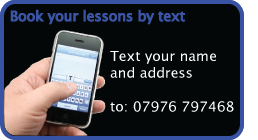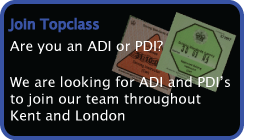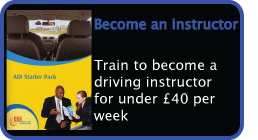 Book a lesson
Book a lesson
Would you like to book a lesson, simply fill in our booking form and we will get back to you to confirm a date.
Please complete all mandatory fields(*)
Topclass driving school Gillingham, driving lessons in Gillingham, Medway, and most of Kent
Topclass Driving School Theory Support
We offer in car theory support and supply mock theory test sheets for free allowing you to study in your own time.
- Who needs to take a test
- Preparation
- How to book
- Documents required
- At the test centre
- Taking your theory test
- Hazard perception test
- At the end of the theory test
- Additional information
Who needs to take a test?
UK licence holders
You will need to take a theory test if you want a licence for a new category of vehicle, for example, if you have a car licence and you want a motorcycle licence you will need to take a theory test.
If, however, you want to upgrade within a vehicle category you will not normally need to take a theory test, for example, if you have a full automatic car licence and you want a manual car licence you will not have to take a theory test.
Please check with the Driver and Vehicle Licensing Agency (DVLA) or the Driving Standards Agency (DSA) if you are unsure if you should take a theory test.
Theory test preparation
Preparing for the theory test
The driving theory test has two parts, part one is a multiple choice test of 50 questions and part two is a hazard perception test of 14 video clips in which you will have to identify 15 developing hazards.
To prepare for both parts of the theory test we recommend that all candidates, regardless of driving experience, use the resource material available.
With your First theory test booking confirmation letter, DSA send you a CD ROM which you should watch. This explains the process of taking the theory test.
How to book a theory test
Before you can take your theory test you will need to make sure you have a valid provisional driving licence. You can apply for a provisional driving licence from the Driver and Vehicle Licensing Agency (DVLA). The application form (form D1) can be obtained from your local Post Office.
For further information about provisional licences please visit the DVLA website, a link can be found in the external links box.
Once you have a valid provisional driving licence you can book your theory test. Waiting times vary from region to region, but the target is that 95% of theory test candidates receive an appointment date within two weeks of their preferred date.
Booking online
To book a theory test online you will need:
- A valid UK driving licence
- A valid debit or credit card for payment (Visa, Mastercard, Delta, Visa Electron, Switch/Maestro and Solo cards are accepted)
Booking by phone
To book a theory test with an operator over the phone you will need:
- A valid UK driving licence
- a valid debit or credit card for payment (Visa, Mastercard, Delta, Visa Electron, Switch/Maestro and Solo cards are accepted)
You can book a theory test over the phone on 0870 01 01 372, from 8.00 am to 6.00 pm, Monday to Friday, except on Bank Holidays, and 8.00am to 4.00pm on Saturdays. You can find a list of booking contact details in the related items box on the right-hand side.
Booking by post
To book a theory test by post you will need an application form. Application forms are available online, on request from the Driving Standards Agency booking line or from theory and practical test centres. Payment can be made by cheque or postal order, but cash payments are not accepted.
Cancelling or rescheduling a test
You can reschedule or cancel a test over the phone via the booking line or you can do it online. Providing you give the DSA three clear working days notice you can:
- Move or change your appointment
- Cancel your appointment
- Have a full refund of test fee
Documents required
Reporting for your theory test
When you arrive at the test centre you will be expected to show both parts of your valid driving licence (the photocard and the paper counterpart).
Old-style driving licences
If you have an old-style paper licence you will also need to take a suitable form of photographic identification. This can be a passport, employer's identity card, student union card, trade union card, school buss pass, a card issued in connection with purchasing rail tickets or a photograph which has been endorsed with a certificate in the prescribed form signed by an acceptable person.
Photographic identification
For photographic identification we will accept the following as long as they bear your photograph and name or signature:
- A passport
- A gun licence
- An employers identity card
- A trade union card
- Cheque/credit card
- Or a photograph of you, which has been signed and dated on the back by an "acceptable person". This must be accompanied with a
statement from the acceptable person confirming in writing in the prescribed format (below) that the photograph is a true likeness
of you.
"I (insert name of certifying officer) certify that this is a true likeness of (insert name of candidate) who has been known to me for (x) months/years in my capacity as (job title)."
- An acceptable person may be:
- An MP or JP
- A solicitor or barrister
- A doctor
- A teacher
- A local councillor
- Your licensing officer
- A bank official
- An established civil servant
- A police officer
- A minister of religion
- An approved driving instructor (not a trainee)
The acceptable person certifying the declaration must sign and date, stating their profession and telephone number - we may make enquiries of confirmation.
Remember:
- No photo
- No test, and
- You will lose your fee!
No licence
At the test centre
Once you have been registered at reception you will go through to the test room. You may not take anything into the room with you; all personal items must be stored in the lockers provided.
Once you are in the test room you may not talk to or distract other candidates. The computer screen will display your name and the category of test you are taking.
If you have any problems during the theory test, you should raise your hand to attract the attention of the test invigilator.
Taking your theory test
The theory test is made up of two parts; the multiple choice part and the hazard perception part. The multiple choice part is delivered using a touch screen computer and mouse and the hazard perception part records your responses through the use of a computer mouse button.
You need to pass both parts to pass the theory test. If you pass one part and fail the other you will fail the whole test, and you will need to take both parts again.
The questions in each multiple choice test vary according to the category of vehicle you are hoping to obtain a licence for, ie a motorcycle theory test will contain specific questions that do not appear in any other test.
For the hazard perception test there are no separate versions for different vehicles, each vehicle category takes the same test, however the pass mark is different for different categories of tests.
Part one - multiple Choice
Before the test starts you will be given instructions on how the test works.
You can also choose to go through a practice session of the multiple choice questions to get used to the layout of the test. At the end of the practice session the real test will begin.
A question and several answer options will appear onscreen and you have to select the correct answer to the question by touching the screen or using the mouse. Some questions may require more than one answer.
You will be asked 50 questions in 40 minutes. You can navigate between questions and 'flag' questions that you want to come back to later in the test.
The pass mark for the multiple choice part of the theory test is 44 out of 50.
After the multiple choice part you can choose to have a break of up to three minutes before the hazard perception part starts.
Part two - hazard perception (coming soon in car hazazrd perception training)
After the break you will then be shown a short tutorial video clip about how the hazard perception part works.
The hazard perception part is also delivered on a computer but you respond by clicking a button on the mouse. You will be presented with a series of 14 video clips which feature every day road scenes. In each clip there will be at least one developing hazard, but one of the clips will feature two developing hazards.
To achieve a high score you will need to respond to the developing hazard during the early part of its development. The maximum you can score on each hazard is five.
You will not be able to review your answers to the hazard perception test; as on the road, you will only have one chance to respond to the developing hazard.
The pass mark for the car and motorcycle hazard perception part of the theory test is 44 out of 75.
At the end of the test
At the end of the hazard perception part of the theory test you will be invited to answer a number of customer survey questions.
You do not have to answer the questions if you do not want to, and any information given is anonymous and confidential. The survey questions do not affect the result of the test.
When you have finished the test you may leave the examination room. Once you have left the room, you will not be allowed to enter it again. You will then be given your result by the test centre staff.
Hazard perception test (coming soon in car hazazrd perception training)
Why was the hazard perception element introduced?
The government is committed to reducing the numbers killed and seriously injured on Britain's roads by 40% by 2010. The hazard perception element was introduced into the driving test in November 2002 as one of the measures that should help achieve this target by encouraging appropriate training in scanning the road, recognising at the first opportunity from the clues that a potentially dangerous situation might arise and adopting a driving plan to reduce the risk.
New drivers are disproportionately involved in accidents, especially in the first months after passing a driving test. It has been proven that drivers who have taken hazard perception training have much better hazard perception skills.
It is also worth pointing out that during the development of this test, the Driving Standards Agency (DSA) worked closely with colleagues from the Transport Research Laboratory (TRL) and the road safety division of the Department for Transport, both of whom thought this test suitable for testing the hazard awareness skills of all drivers.
Are there separate versions of the hazard perception test for each category?
Recognition of available clues and perception of danger are skills that are necessary in all drivers and riders, irrespective of the vehicle used. For this reason, the same version of the hazard perception test is used for all categories of test.
How does the hazard perception test work?
The hazard perception part is delivered on a computer and you respond by clicking a button on the mouse. You will be presented with a series of 14 video clips which feature every day road scenes, in each clip there will be at least one developing hazard, but one of the clips will feature two developing hazards.
To achieve a high score you will need to respond to the developing hazard during the early part of its development. The maximum you can score on each hazard is five.
An example of when to respond
As an example, of how to identify and respond to a developing hazard, consider a parked vehicle on the side of the road. When you first see it, it is not doing anything; it is just a parked vehicle. If you were to respond to the vehicle at this point, you would not score any marks, but you would not lose any marks.
However, when you get closer to the vehicle, you notice that the car's right hand indicator starts to flash. The indicator would lead you to believe that the driver of the vehicle has an intention of moving away, therefore the hazard is now developing and a response at this point would score marks. The indicator coming on is a sign that the parked vehicle has changed its status from a potential hazard into a developing hazard.
When you get closer to the vehicle, you will probably see the vehicle start to move away from the side of the road; another response should be made at this point. Different clips in the test will have various signs to indicate that the hazard is changing its status and is now starting to develop.
Scoring
The maximum you can score for each developing hazard is five points. If you respond throughout the developing hazard and score different points you will always score the highest number of points ie if you react and score five then three then two points you will be awarded five points.
You will not be able to review your answers to the hazard perception test; as on the road, you will only have one chance to respond to the developing hazard, so you will need to concentrate throughout each clip.
If you react inappropriately during the video clip by clicking continuously or in a pattern of responses you will score zero for that clip. At the end of the clip a pop-up box will appear informing you that you have scored zero for that particular clip.
At the end of the theory test
At the end of the test, you will be given your result letter by the test centre staff.
The letter tells you if you passed or failed, and it gives you feedback on your test. It tells you in which topic areas you answered questions incorrectly, so you know which topics to look at again, and it tells you the breakdown of points you scored throughout the hazard perception part ie how many 5's, 4's, 3's you scored.
If you scored mainly 0's, 1's and 2's you are reacting slowly to the hazard that is developing onscreen, whereas if you scored mainly 5's and 4's you are identifying the developing hazards in good time.
If you pass..
If you passed, you will also receive your theory test certificate which has your theory test number on. You will need this number when you book your practical test.
Your theory test certificate is valid for two years from the date of your test. If you do not take your practical test within this two year period you will have to take another theory test. There are no exceptions to this rule.
If you fail..
If you fail the theory test you should look at the feedback given on the letter and identify why you failed.
If you want to book another theory test you can book a test straight away, but you cannot take the test for another three clear working days. So, if you failed your first test on Monday afternoon, you will have to wait until Friday morning before you can take your next theory test.
Additional Source of Theory Guidance..
The DSA have two mock tests on their web site. Go to www.dsa.gov.uk and on the left click on 'Theory Tests' followed by 'Mock Theory Tests'. Finally on the right select 'Car Test 1' or 'Car Test 2'
For your convenience we now accept all major credit / debit cards.





















